Business Environment Analysis: A Report on Tesco's Strategic Response
VerifiedAdded on 2022/11/26
|19
|7053
|183
Report
AI Summary
This report provides a comprehensive analysis of Tesco's strategic responses to its external environment. It begins by identifying key features of the external environment, such as its dynamic, interrelated, complex, and multifaceted nature, and assesses their impact on Tesco. The report then examines Tesco's responses to these factors, including its flexible organizational structure, improved decision-making processes, sustainability approach, contingent strategies, and leadership development programs. The analysis highlights how Tesco adapts to changes in the business environment, utilizes resources effectively, and addresses the needs of stakeholders. The report emphasizes the importance of strategic evaluation and adaptation for contemporary organizations, especially in a dynamic global market. The report also explores the company's approach to sustainability and its focus on employee training and development. The overall strategy of Tesco and the potential opportunities available for the company are also included in the report. It concludes with an appraisal of the strategic solutions employed by Tesco, emphasizing the firm's ability to remain competitive.
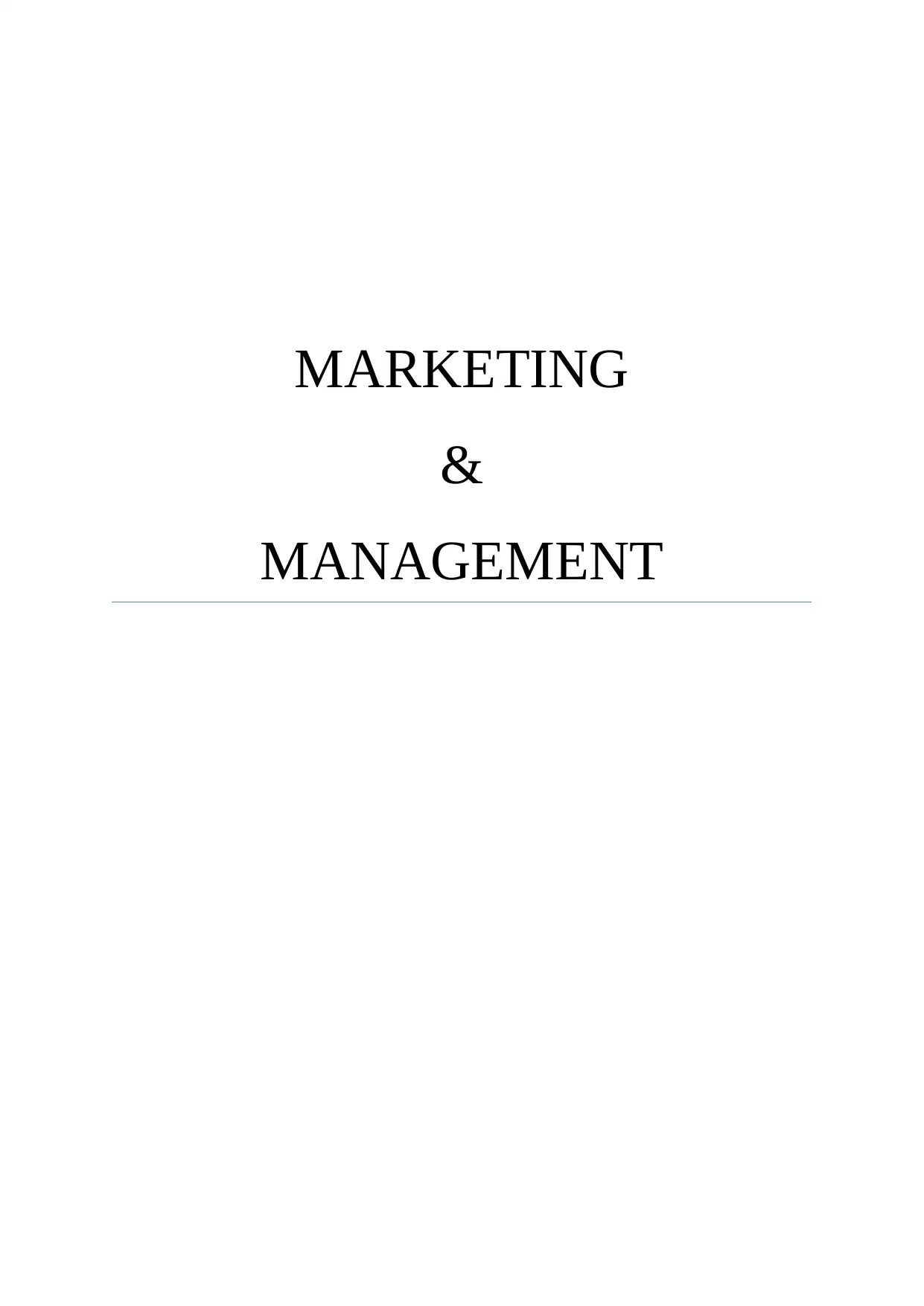
MARKETING
&
MANAGEMENT
&
MANAGEMENT
Paraphrase This Document
Need a fresh take? Get an instant paraphrase of this document with our AI Paraphraser
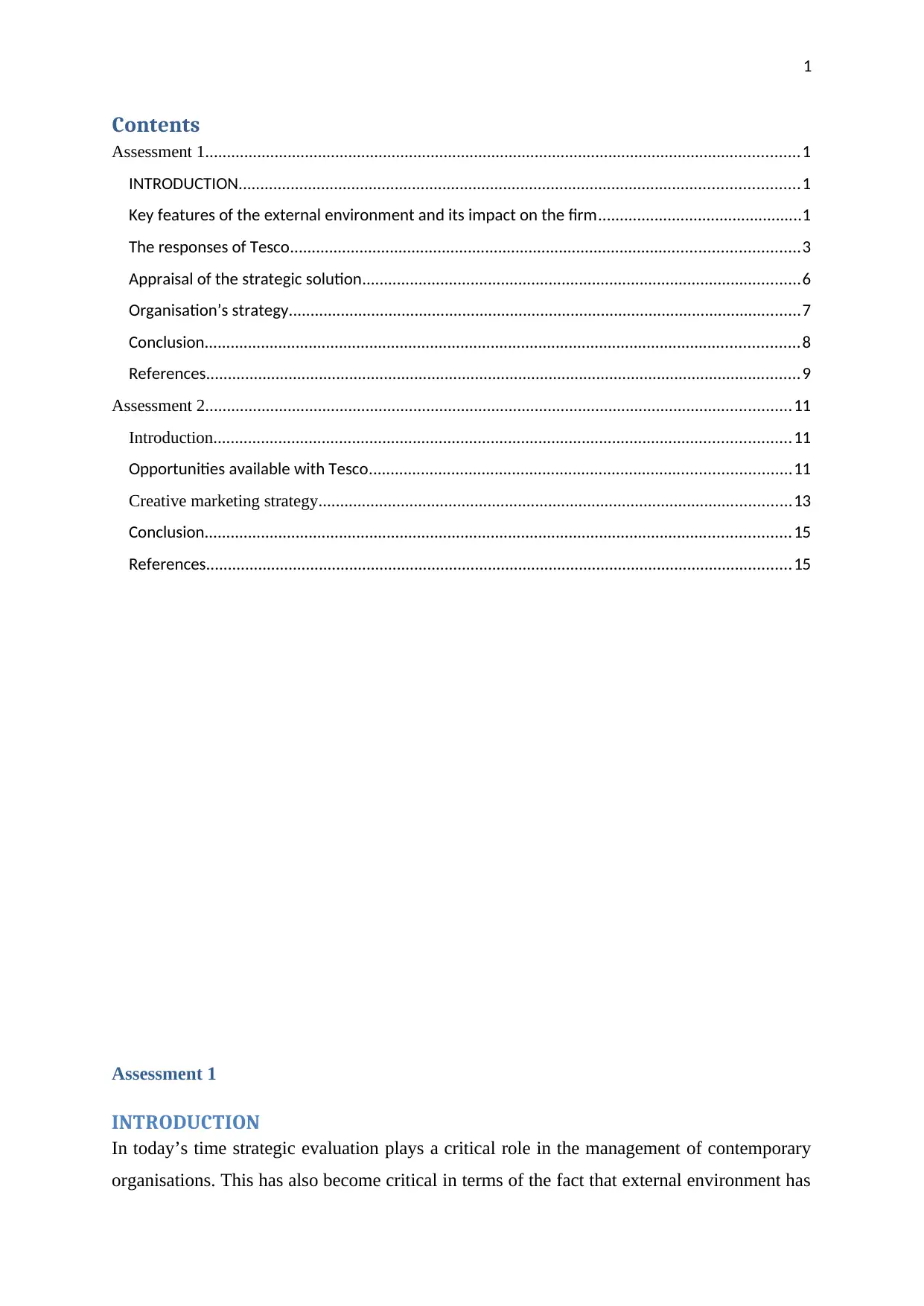
1
Contents
Assessment 1.........................................................................................................................................1
INTRODUCTION.................................................................................................................................1
Key features of the external environment and its impact on the firm...............................................1
The responses of Tesco.....................................................................................................................3
Appraisal of the strategic solution.....................................................................................................6
Organisation’s strategy......................................................................................................................7
Conclusion.........................................................................................................................................8
References.........................................................................................................................................9
Assessment 2.......................................................................................................................................11
Introduction.....................................................................................................................................11
Opportunities available with Tesco.................................................................................................11
Creative marketing strategy.............................................................................................................13
Conclusion.......................................................................................................................................15
References.......................................................................................................................................15
Assessment 1
INTRODUCTION
In today’s time strategic evaluation plays a critical role in the management of contemporary
organisations. This has also become critical in terms of the fact that external environment has
Contents
Assessment 1.........................................................................................................................................1
INTRODUCTION.................................................................................................................................1
Key features of the external environment and its impact on the firm...............................................1
The responses of Tesco.....................................................................................................................3
Appraisal of the strategic solution.....................................................................................................6
Organisation’s strategy......................................................................................................................7
Conclusion.........................................................................................................................................8
References.........................................................................................................................................9
Assessment 2.......................................................................................................................................11
Introduction.....................................................................................................................................11
Opportunities available with Tesco.................................................................................................11
Creative marketing strategy.............................................................................................................13
Conclusion.......................................................................................................................................15
References.......................................................................................................................................15
Assessment 1
INTRODUCTION
In today’s time strategic evaluation plays a critical role in the management of contemporary
organisations. This has also become critical in terms of the fact that external environment has
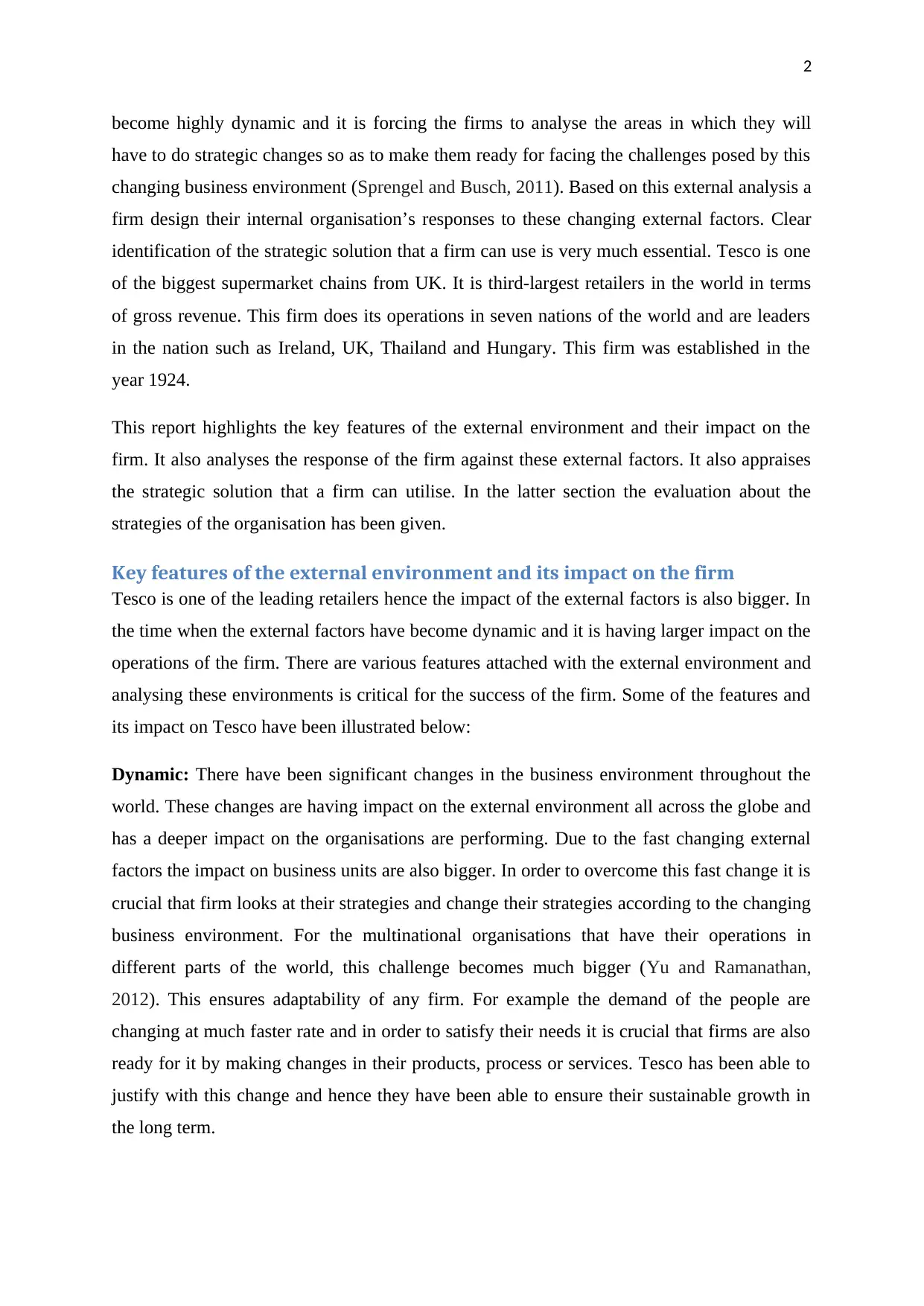
2
become highly dynamic and it is forcing the firms to analyse the areas in which they will
have to do strategic changes so as to make them ready for facing the challenges posed by this
changing business environment (Sprengel and Busch, 2011). Based on this external analysis a
firm design their internal organisation’s responses to these changing external factors. Clear
identification of the strategic solution that a firm can use is very much essential. Tesco is one
of the biggest supermarket chains from UK. It is third-largest retailers in the world in terms
of gross revenue. This firm does its operations in seven nations of the world and are leaders
in the nation such as Ireland, UK, Thailand and Hungary. This firm was established in the
year 1924.
This report highlights the key features of the external environment and their impact on the
firm. It also analyses the response of the firm against these external factors. It also appraises
the strategic solution that a firm can utilise. In the latter section the evaluation about the
strategies of the organisation has been given.
Key features of the external environment and its impact on the firm
Tesco is one of the leading retailers hence the impact of the external factors is also bigger. In
the time when the external factors have become dynamic and it is having larger impact on the
operations of the firm. There are various features attached with the external environment and
analysing these environments is critical for the success of the firm. Some of the features and
its impact on Tesco have been illustrated below:
Dynamic: There have been significant changes in the business environment throughout the
world. These changes are having impact on the external environment all across the globe and
has a deeper impact on the organisations are performing. Due to the fast changing external
factors the impact on business units are also bigger. In order to overcome this fast change it is
crucial that firm looks at their strategies and change their strategies according to the changing
business environment. For the multinational organisations that have their operations in
different parts of the world, this challenge becomes much bigger (Yu and Ramanathan,
2012). This ensures adaptability of any firm. For example the demand of the people are
changing at much faster rate and in order to satisfy their needs it is crucial that firms are also
ready for it by making changes in their products, process or services. Tesco has been able to
justify with this change and hence they have been able to ensure their sustainable growth in
the long term.
become highly dynamic and it is forcing the firms to analyse the areas in which they will
have to do strategic changes so as to make them ready for facing the challenges posed by this
changing business environment (Sprengel and Busch, 2011). Based on this external analysis a
firm design their internal organisation’s responses to these changing external factors. Clear
identification of the strategic solution that a firm can use is very much essential. Tesco is one
of the biggest supermarket chains from UK. It is third-largest retailers in the world in terms
of gross revenue. This firm does its operations in seven nations of the world and are leaders
in the nation such as Ireland, UK, Thailand and Hungary. This firm was established in the
year 1924.
This report highlights the key features of the external environment and their impact on the
firm. It also analyses the response of the firm against these external factors. It also appraises
the strategic solution that a firm can utilise. In the latter section the evaluation about the
strategies of the organisation has been given.
Key features of the external environment and its impact on the firm
Tesco is one of the leading retailers hence the impact of the external factors is also bigger. In
the time when the external factors have become dynamic and it is having larger impact on the
operations of the firm. There are various features attached with the external environment and
analysing these environments is critical for the success of the firm. Some of the features and
its impact on Tesco have been illustrated below:
Dynamic: There have been significant changes in the business environment throughout the
world. These changes are having impact on the external environment all across the globe and
has a deeper impact on the organisations are performing. Due to the fast changing external
factors the impact on business units are also bigger. In order to overcome this fast change it is
crucial that firm looks at their strategies and change their strategies according to the changing
business environment. For the multinational organisations that have their operations in
different parts of the world, this challenge becomes much bigger (Yu and Ramanathan,
2012). This ensures adaptability of any firm. For example the demand of the people are
changing at much faster rate and in order to satisfy their needs it is crucial that firms are also
ready for it by making changes in their products, process or services. Tesco has been able to
justify with this change and hence they have been able to ensure their sustainable growth in
the long term.
⊘ This is a preview!⊘
Do you want full access?
Subscribe today to unlock all pages.

Trusted by 1+ million students worldwide
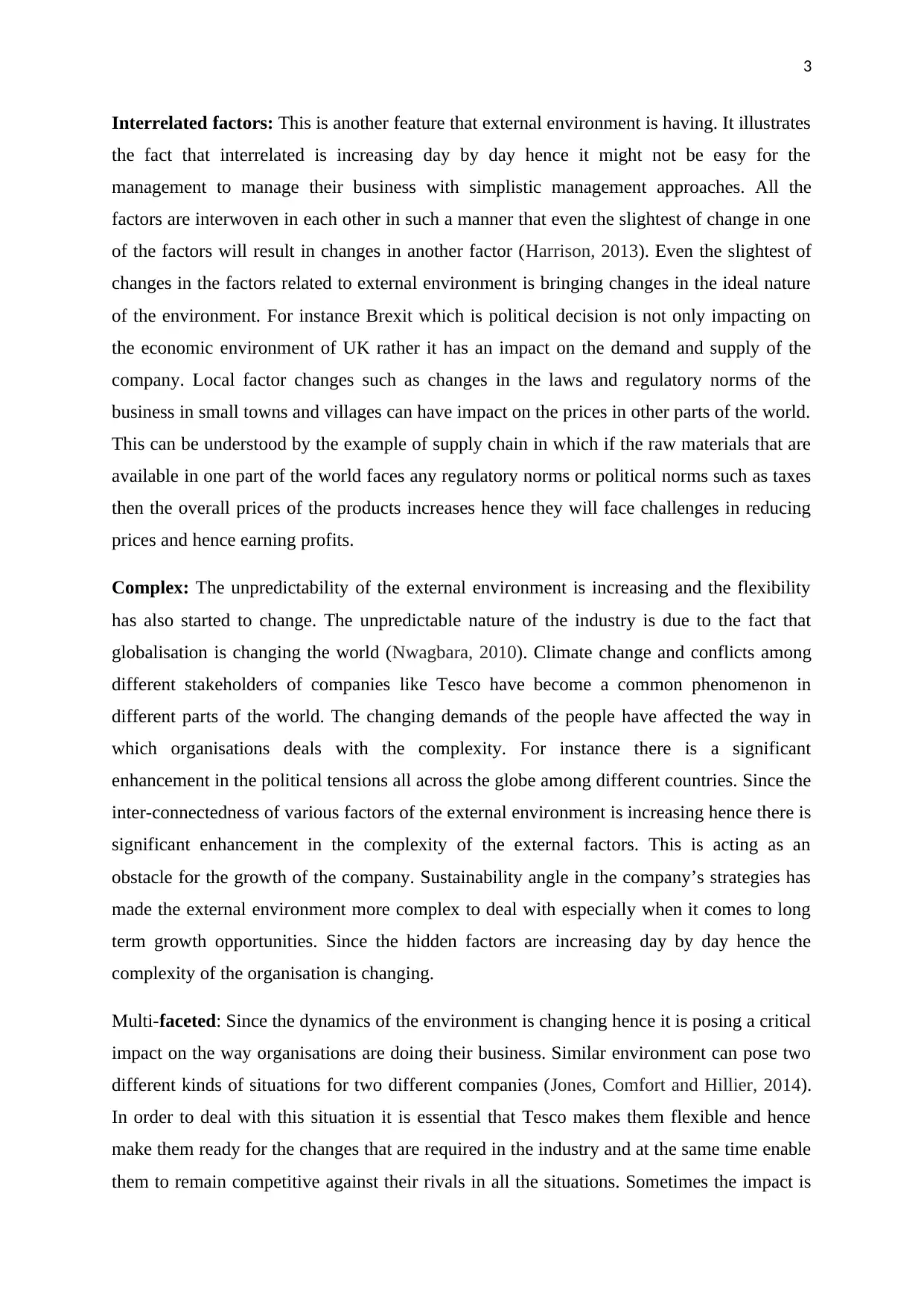
3
Interrelated factors: This is another feature that external environment is having. It illustrates
the fact that interrelated is increasing day by day hence it might not be easy for the
management to manage their business with simplistic management approaches. All the
factors are interwoven in each other in such a manner that even the slightest of change in one
of the factors will result in changes in another factor (Harrison, 2013). Even the slightest of
changes in the factors related to external environment is bringing changes in the ideal nature
of the environment. For instance Brexit which is political decision is not only impacting on
the economic environment of UK rather it has an impact on the demand and supply of the
company. Local factor changes such as changes in the laws and regulatory norms of the
business in small towns and villages can have impact on the prices in other parts of the world.
This can be understood by the example of supply chain in which if the raw materials that are
available in one part of the world faces any regulatory norms or political norms such as taxes
then the overall prices of the products increases hence they will face challenges in reducing
prices and hence earning profits.
Complex: The unpredictability of the external environment is increasing and the flexibility
has also started to change. The unpredictable nature of the industry is due to the fact that
globalisation is changing the world (Nwagbara, 2010). Climate change and conflicts among
different stakeholders of companies like Tesco have become a common phenomenon in
different parts of the world. The changing demands of the people have affected the way in
which organisations deals with the complexity. For instance there is a significant
enhancement in the political tensions all across the globe among different countries. Since the
inter-connectedness of various factors of the external environment is increasing hence there is
significant enhancement in the complexity of the external factors. This is acting as an
obstacle for the growth of the company. Sustainability angle in the company’s strategies has
made the external environment more complex to deal with especially when it comes to long
term growth opportunities. Since the hidden factors are increasing day by day hence the
complexity of the organisation is changing.
Multi-faceted: Since the dynamics of the environment is changing hence it is posing a critical
impact on the way organisations are doing their business. Similar environment can pose two
different kinds of situations for two different companies (Jones, Comfort and Hillier, 2014).
In order to deal with this situation it is essential that Tesco makes them flexible and hence
make them ready for the changes that are required in the industry and at the same time enable
them to remain competitive against their rivals in all the situations. Sometimes the impact is
Interrelated factors: This is another feature that external environment is having. It illustrates
the fact that interrelated is increasing day by day hence it might not be easy for the
management to manage their business with simplistic management approaches. All the
factors are interwoven in each other in such a manner that even the slightest of change in one
of the factors will result in changes in another factor (Harrison, 2013). Even the slightest of
changes in the factors related to external environment is bringing changes in the ideal nature
of the environment. For instance Brexit which is political decision is not only impacting on
the economic environment of UK rather it has an impact on the demand and supply of the
company. Local factor changes such as changes in the laws and regulatory norms of the
business in small towns and villages can have impact on the prices in other parts of the world.
This can be understood by the example of supply chain in which if the raw materials that are
available in one part of the world faces any regulatory norms or political norms such as taxes
then the overall prices of the products increases hence they will face challenges in reducing
prices and hence earning profits.
Complex: The unpredictability of the external environment is increasing and the flexibility
has also started to change. The unpredictable nature of the industry is due to the fact that
globalisation is changing the world (Nwagbara, 2010). Climate change and conflicts among
different stakeholders of companies like Tesco have become a common phenomenon in
different parts of the world. The changing demands of the people have affected the way in
which organisations deals with the complexity. For instance there is a significant
enhancement in the political tensions all across the globe among different countries. Since the
inter-connectedness of various factors of the external environment is increasing hence there is
significant enhancement in the complexity of the external factors. This is acting as an
obstacle for the growth of the company. Sustainability angle in the company’s strategies has
made the external environment more complex to deal with especially when it comes to long
term growth opportunities. Since the hidden factors are increasing day by day hence the
complexity of the organisation is changing.
Multi-faceted: Since the dynamics of the environment is changing hence it is posing a critical
impact on the way organisations are doing their business. Similar environment can pose two
different kinds of situations for two different companies (Jones, Comfort and Hillier, 2014).
In order to deal with this situation it is essential that Tesco makes them flexible and hence
make them ready for the changes that are required in the industry and at the same time enable
them to remain competitive against their rivals in all the situations. Sometimes the impact is
Paraphrase This Document
Need a fresh take? Get an instant paraphrase of this document with our AI Paraphraser

4
so severe that it leads to the downfall of one company ad rise of the other. This is
significantly understood with the example of changing technology needs of the consumers
which illustrates the fact that for the companies like Tesco it is beneficial as they are able to
provide better services to their consumers but on the other hand it is becoming difficult for
the small scale organisations to do their business.
The responses of Tesco
According to the characteristics of the external environment discussed in the above section of
the report, it is critical that Tesco responds in an appropriate manner so as to remain
competitive to the business environment. The responses that Tesco can give to these
characteristics of the external environment are:
Flexible organisational structure: In order to deal with the changes in the business
environment and the changes in the factors that affect the business environment. Flexible
organisational structure allows firms to effectively utilise their resources. Since the numbers
of stakeholders that are attached with the firms are increasing hence the impact of the
external environment is getting bigger. Flexible organisational structure allows companies to
face uncertainty in the business environment (Arvaniti, 2010). This can be understood in
terms of the fact that whatever may be the changes in the business environment Tesco will be
able to handle it by placing right people at the right position for the right job.
Decision making process: Previously the decisions were generally made at the management
levels but now Tesco has expanded its decision making capacity by engaging more numbers
of stakeholders in the decision making process. Better decisions are made with the help of
this kind of decision making process and it also ensures that all the needs and requirements of
the people due to the change in the external environment is being addressed by the company.
Tesco has added more numbers of routes to collect feedbacks from their stakeholders. The
use of technology has magnified this process and has made them capable of dealing with the
changes in the external environment however fast may be the changes (lal Bhardwaj, 2012).
This decision making process in the Tesco is also supported by the help of the data analytics
and predictive technology. What it does is that it improves the way in which decisions are
being made within the firm as with the help of data more factual and genuine decisions can
be made. Predictive analytics helps in predicting the uncertainties and possibilities that might
arise in the future and hence it enables the company to look for long term approaches.
so severe that it leads to the downfall of one company ad rise of the other. This is
significantly understood with the example of changing technology needs of the consumers
which illustrates the fact that for the companies like Tesco it is beneficial as they are able to
provide better services to their consumers but on the other hand it is becoming difficult for
the small scale organisations to do their business.
The responses of Tesco
According to the characteristics of the external environment discussed in the above section of
the report, it is critical that Tesco responds in an appropriate manner so as to remain
competitive to the business environment. The responses that Tesco can give to these
characteristics of the external environment are:
Flexible organisational structure: In order to deal with the changes in the business
environment and the changes in the factors that affect the business environment. Flexible
organisational structure allows firms to effectively utilise their resources. Since the numbers
of stakeholders that are attached with the firms are increasing hence the impact of the
external environment is getting bigger. Flexible organisational structure allows companies to
face uncertainty in the business environment (Arvaniti, 2010). This can be understood in
terms of the fact that whatever may be the changes in the business environment Tesco will be
able to handle it by placing right people at the right position for the right job.
Decision making process: Previously the decisions were generally made at the management
levels but now Tesco has expanded its decision making capacity by engaging more numbers
of stakeholders in the decision making process. Better decisions are made with the help of
this kind of decision making process and it also ensures that all the needs and requirements of
the people due to the change in the external environment is being addressed by the company.
Tesco has added more numbers of routes to collect feedbacks from their stakeholders. The
use of technology has magnified this process and has made them capable of dealing with the
changes in the external environment however fast may be the changes (lal Bhardwaj, 2012).
This decision making process in the Tesco is also supported by the help of the data analytics
and predictive technology. What it does is that it improves the way in which decisions are
being made within the firm as with the help of data more factual and genuine decisions can
be made. Predictive analytics helps in predicting the uncertainties and possibilities that might
arise in the future and hence it enables the company to look for long term approaches.
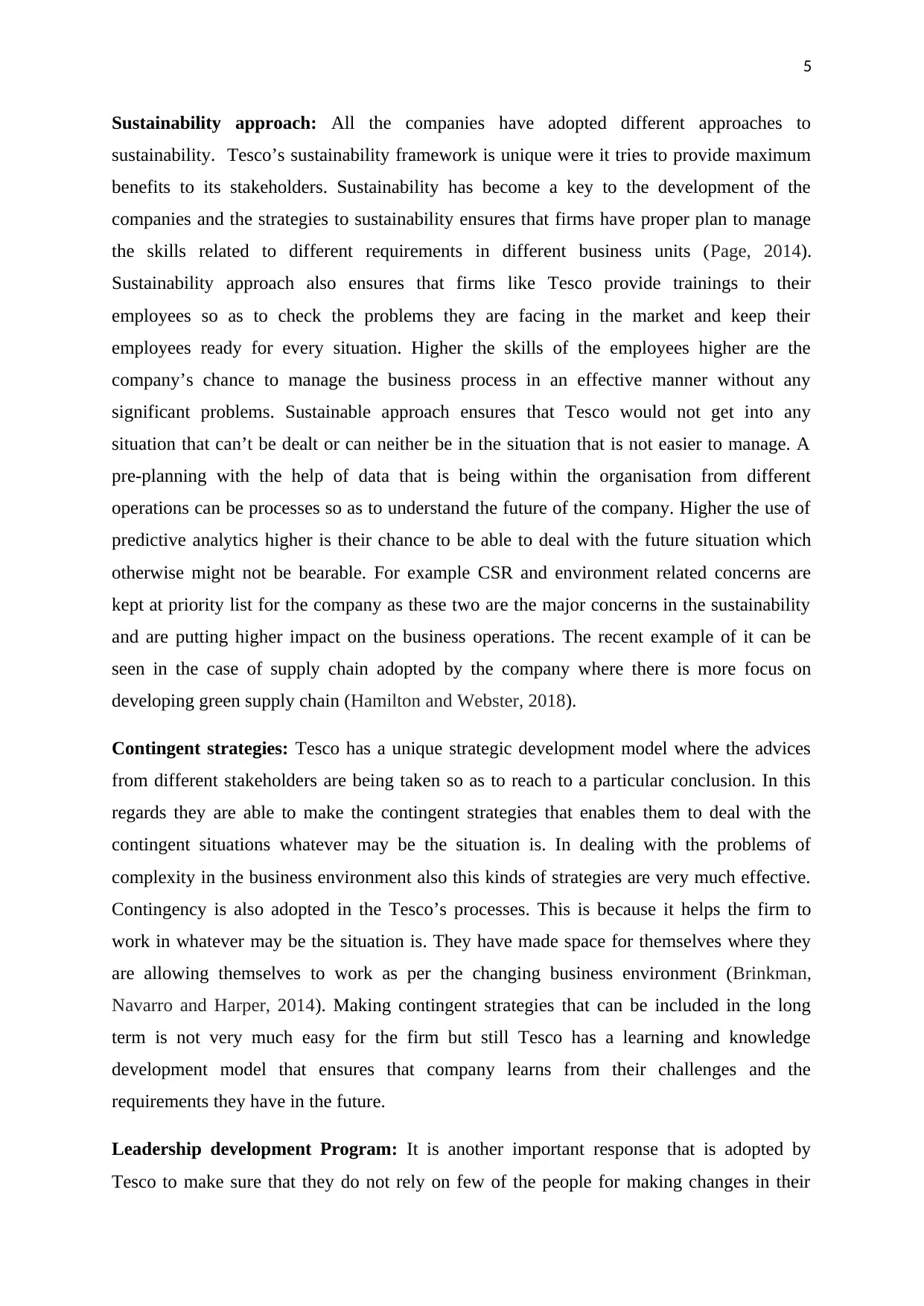
5
Sustainability approach: All the companies have adopted different approaches to
sustainability. Tesco’s sustainability framework is unique were it tries to provide maximum
benefits to its stakeholders. Sustainability has become a key to the development of the
companies and the strategies to sustainability ensures that firms have proper plan to manage
the skills related to different requirements in different business units (Page, 2014).
Sustainability approach also ensures that firms like Tesco provide trainings to their
employees so as to check the problems they are facing in the market and keep their
employees ready for every situation. Higher the skills of the employees higher are the
company’s chance to manage the business process in an effective manner without any
significant problems. Sustainable approach ensures that Tesco would not get into any
situation that can’t be dealt or can neither be in the situation that is not easier to manage. A
pre-planning with the help of data that is being within the organisation from different
operations can be processes so as to understand the future of the company. Higher the use of
predictive analytics higher is their chance to be able to deal with the future situation which
otherwise might not be bearable. For example CSR and environment related concerns are
kept at priority list for the company as these two are the major concerns in the sustainability
and are putting higher impact on the business operations. The recent example of it can be
seen in the case of supply chain adopted by the company where there is more focus on
developing green supply chain (Hamilton and Webster, 2018).
Contingent strategies: Tesco has a unique strategic development model where the advices
from different stakeholders are being taken so as to reach to a particular conclusion. In this
regards they are able to make the contingent strategies that enables them to deal with the
contingent situations whatever may be the situation is. In dealing with the problems of
complexity in the business environment also this kinds of strategies are very much effective.
Contingency is also adopted in the Tesco’s processes. This is because it helps the firm to
work in whatever may be the situation is. They have made space for themselves where they
are allowing themselves to work as per the changing business environment (Brinkman,
Navarro and Harper, 2014). Making contingent strategies that can be included in the long
term is not very much easy for the firm but still Tesco has a learning and knowledge
development model that ensures that company learns from their challenges and the
requirements they have in the future.
Leadership development Program: It is another important response that is adopted by
Tesco to make sure that they do not rely on few of the people for making changes in their
Sustainability approach: All the companies have adopted different approaches to
sustainability. Tesco’s sustainability framework is unique were it tries to provide maximum
benefits to its stakeholders. Sustainability has become a key to the development of the
companies and the strategies to sustainability ensures that firms have proper plan to manage
the skills related to different requirements in different business units (Page, 2014).
Sustainability approach also ensures that firms like Tesco provide trainings to their
employees so as to check the problems they are facing in the market and keep their
employees ready for every situation. Higher the skills of the employees higher are the
company’s chance to manage the business process in an effective manner without any
significant problems. Sustainable approach ensures that Tesco would not get into any
situation that can’t be dealt or can neither be in the situation that is not easier to manage. A
pre-planning with the help of data that is being within the organisation from different
operations can be processes so as to understand the future of the company. Higher the use of
predictive analytics higher is their chance to be able to deal with the future situation which
otherwise might not be bearable. For example CSR and environment related concerns are
kept at priority list for the company as these two are the major concerns in the sustainability
and are putting higher impact on the business operations. The recent example of it can be
seen in the case of supply chain adopted by the company where there is more focus on
developing green supply chain (Hamilton and Webster, 2018).
Contingent strategies: Tesco has a unique strategic development model where the advices
from different stakeholders are being taken so as to reach to a particular conclusion. In this
regards they are able to make the contingent strategies that enables them to deal with the
contingent situations whatever may be the situation is. In dealing with the problems of
complexity in the business environment also this kinds of strategies are very much effective.
Contingency is also adopted in the Tesco’s processes. This is because it helps the firm to
work in whatever may be the situation is. They have made space for themselves where they
are allowing themselves to work as per the changing business environment (Brinkman,
Navarro and Harper, 2014). Making contingent strategies that can be included in the long
term is not very much easy for the firm but still Tesco has a learning and knowledge
development model that ensures that company learns from their challenges and the
requirements they have in the future.
Leadership development Program: It is another important response that is adopted by
Tesco to make sure that they do not rely on few of the people for making changes in their
⊘ This is a preview!⊘
Do you want full access?
Subscribe today to unlock all pages.

Trusted by 1+ million students worldwide
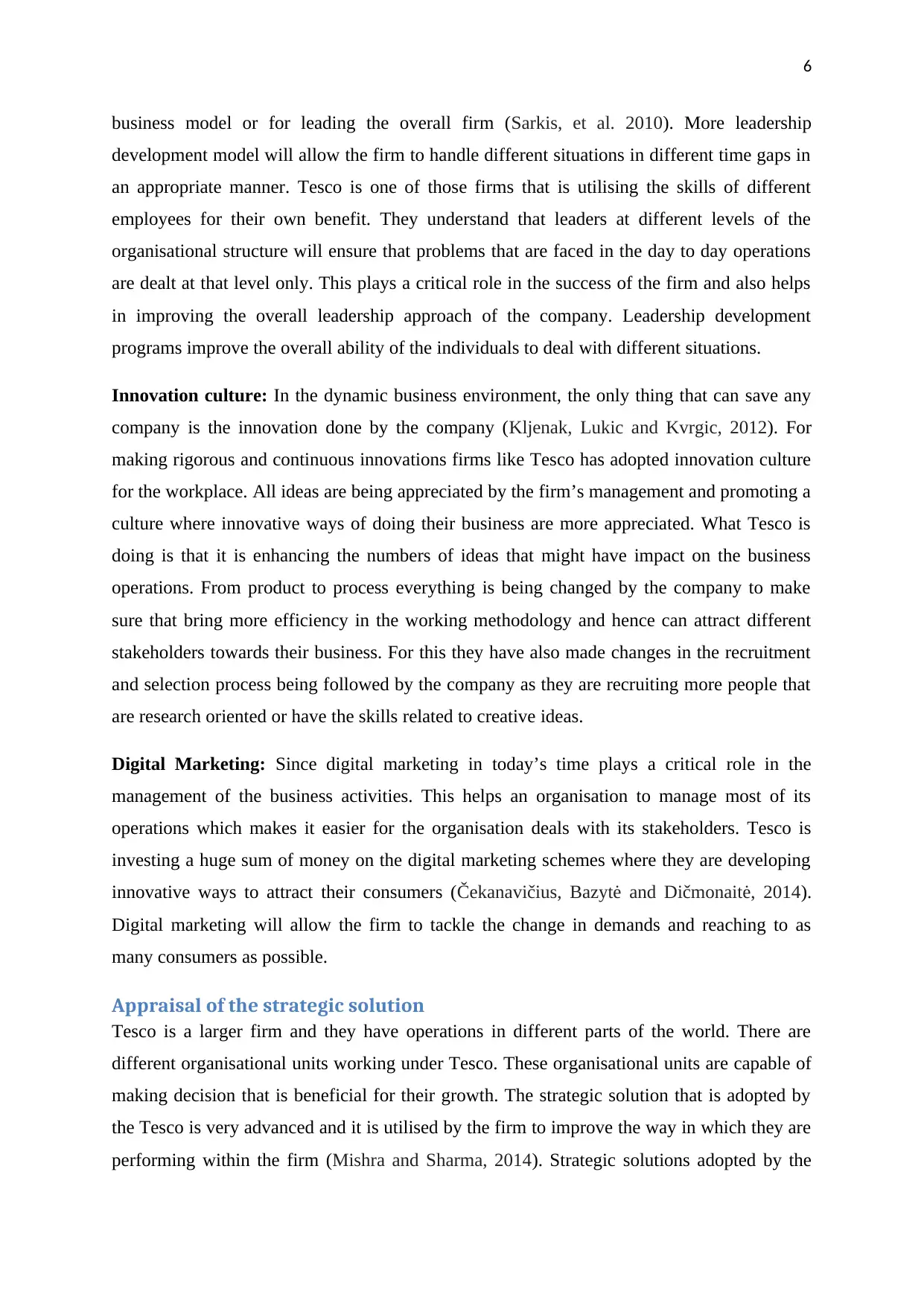
6
business model or for leading the overall firm (Sarkis, et al. 2010). More leadership
development model will allow the firm to handle different situations in different time gaps in
an appropriate manner. Tesco is one of those firms that is utilising the skills of different
employees for their own benefit. They understand that leaders at different levels of the
organisational structure will ensure that problems that are faced in the day to day operations
are dealt at that level only. This plays a critical role in the success of the firm and also helps
in improving the overall leadership approach of the company. Leadership development
programs improve the overall ability of the individuals to deal with different situations.
Innovation culture: In the dynamic business environment, the only thing that can save any
company is the innovation done by the company (Kljenak, Lukic and Kvrgic, 2012). For
making rigorous and continuous innovations firms like Tesco has adopted innovation culture
for the workplace. All ideas are being appreciated by the firm’s management and promoting a
culture where innovative ways of doing their business are more appreciated. What Tesco is
doing is that it is enhancing the numbers of ideas that might have impact on the business
operations. From product to process everything is being changed by the company to make
sure that bring more efficiency in the working methodology and hence can attract different
stakeholders towards their business. For this they have also made changes in the recruitment
and selection process being followed by the company as they are recruiting more people that
are research oriented or have the skills related to creative ideas.
Digital Marketing: Since digital marketing in today’s time plays a critical role in the
management of the business activities. This helps an organisation to manage most of its
operations which makes it easier for the organisation deals with its stakeholders. Tesco is
investing a huge sum of money on the digital marketing schemes where they are developing
innovative ways to attract their consumers (Čekanavičius, Bazytė and Dičmonaitė, 2014).
Digital marketing will allow the firm to tackle the change in demands and reaching to as
many consumers as possible.
Appraisal of the strategic solution
Tesco is a larger firm and they have operations in different parts of the world. There are
different organisational units working under Tesco. These organisational units are capable of
making decision that is beneficial for their growth. The strategic solution that is adopted by
the Tesco is very advanced and it is utilised by the firm to improve the way in which they are
performing within the firm (Mishra and Sharma, 2014). Strategic solutions adopted by the
business model or for leading the overall firm (Sarkis, et al. 2010). More leadership
development model will allow the firm to handle different situations in different time gaps in
an appropriate manner. Tesco is one of those firms that is utilising the skills of different
employees for their own benefit. They understand that leaders at different levels of the
organisational structure will ensure that problems that are faced in the day to day operations
are dealt at that level only. This plays a critical role in the success of the firm and also helps
in improving the overall leadership approach of the company. Leadership development
programs improve the overall ability of the individuals to deal with different situations.
Innovation culture: In the dynamic business environment, the only thing that can save any
company is the innovation done by the company (Kljenak, Lukic and Kvrgic, 2012). For
making rigorous and continuous innovations firms like Tesco has adopted innovation culture
for the workplace. All ideas are being appreciated by the firm’s management and promoting a
culture where innovative ways of doing their business are more appreciated. What Tesco is
doing is that it is enhancing the numbers of ideas that might have impact on the business
operations. From product to process everything is being changed by the company to make
sure that bring more efficiency in the working methodology and hence can attract different
stakeholders towards their business. For this they have also made changes in the recruitment
and selection process being followed by the company as they are recruiting more people that
are research oriented or have the skills related to creative ideas.
Digital Marketing: Since digital marketing in today’s time plays a critical role in the
management of the business activities. This helps an organisation to manage most of its
operations which makes it easier for the organisation deals with its stakeholders. Tesco is
investing a huge sum of money on the digital marketing schemes where they are developing
innovative ways to attract their consumers (Čekanavičius, Bazytė and Dičmonaitė, 2014).
Digital marketing will allow the firm to tackle the change in demands and reaching to as
many consumers as possible.
Appraisal of the strategic solution
Tesco is a larger firm and they have operations in different parts of the world. There are
different organisational units working under Tesco. These organisational units are capable of
making decision that is beneficial for their growth. The strategic solution that is adopted by
the Tesco is very advanced and it is utilised by the firm to improve the way in which they are
performing within the firm (Mishra and Sharma, 2014). Strategic solutions adopted by the
Paraphrase This Document
Need a fresh take? Get an instant paraphrase of this document with our AI Paraphraser
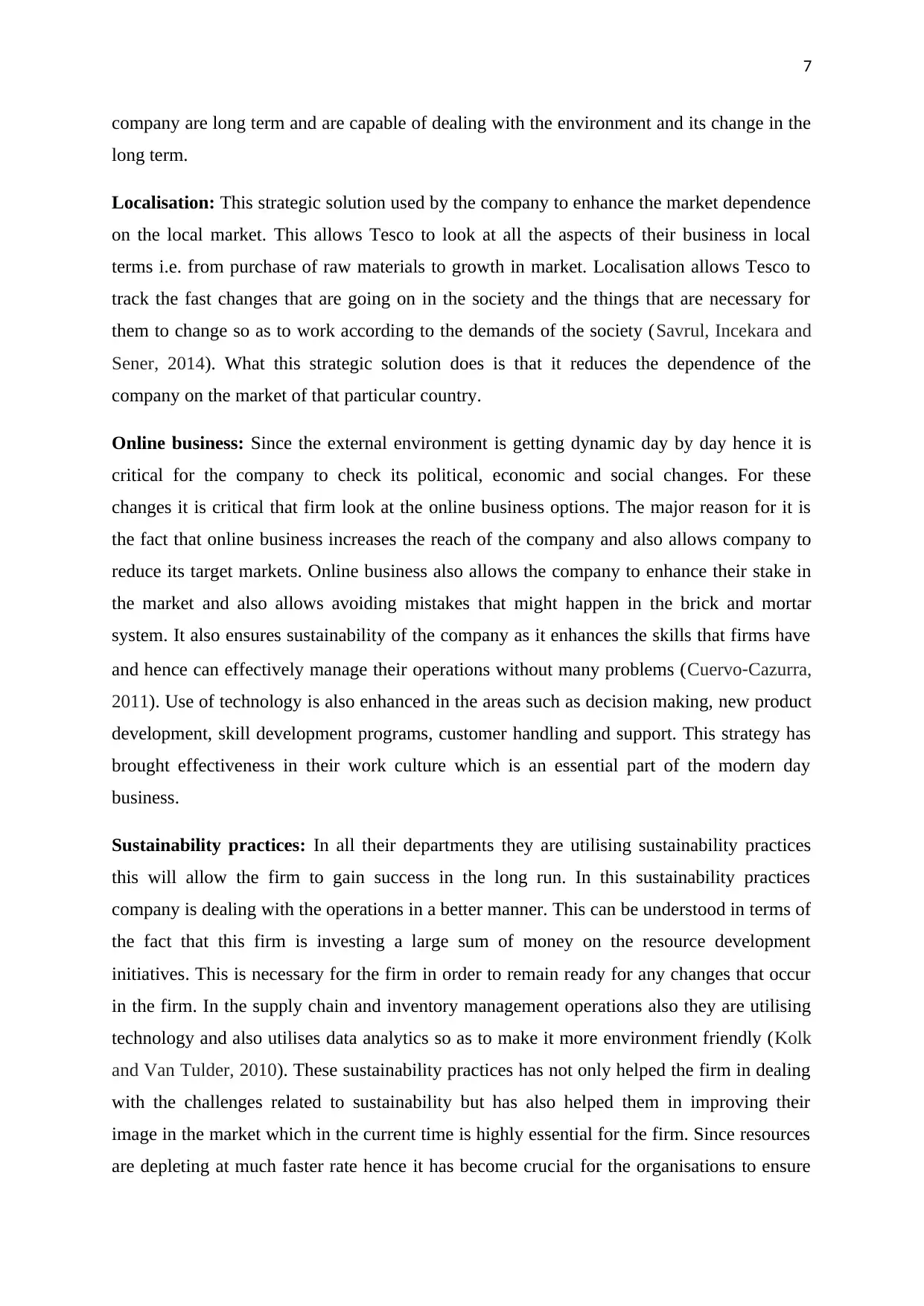
7
company are long term and are capable of dealing with the environment and its change in the
long term.
Localisation: This strategic solution used by the company to enhance the market dependence
on the local market. This allows Tesco to look at all the aspects of their business in local
terms i.e. from purchase of raw materials to growth in market. Localisation allows Tesco to
track the fast changes that are going on in the society and the things that are necessary for
them to change so as to work according to the demands of the society (Savrul, Incekara and
Sener, 2014). What this strategic solution does is that it reduces the dependence of the
company on the market of that particular country.
Online business: Since the external environment is getting dynamic day by day hence it is
critical for the company to check its political, economic and social changes. For these
changes it is critical that firm look at the online business options. The major reason for it is
the fact that online business increases the reach of the company and also allows company to
reduce its target markets. Online business also allows the company to enhance their stake in
the market and also allows avoiding mistakes that might happen in the brick and mortar
system. It also ensures sustainability of the company as it enhances the skills that firms have
and hence can effectively manage their operations without many problems (Cuervo‐Cazurra,
2011). Use of technology is also enhanced in the areas such as decision making, new product
development, skill development programs, customer handling and support. This strategy has
brought effectiveness in their work culture which is an essential part of the modern day
business.
Sustainability practices: In all their departments they are utilising sustainability practices
this will allow the firm to gain success in the long run. In this sustainability practices
company is dealing with the operations in a better manner. This can be understood in terms of
the fact that this firm is investing a large sum of money on the resource development
initiatives. This is necessary for the firm in order to remain ready for any changes that occur
in the firm. In the supply chain and inventory management operations also they are utilising
technology and also utilises data analytics so as to make it more environment friendly (Kolk
and Van Tulder, 2010). These sustainability practices has not only helped the firm in dealing
with the challenges related to sustainability but has also helped them in improving their
image in the market which in the current time is highly essential for the firm. Since resources
are depleting at much faster rate hence it has become crucial for the organisations to ensure
company are long term and are capable of dealing with the environment and its change in the
long term.
Localisation: This strategic solution used by the company to enhance the market dependence
on the local market. This allows Tesco to look at all the aspects of their business in local
terms i.e. from purchase of raw materials to growth in market. Localisation allows Tesco to
track the fast changes that are going on in the society and the things that are necessary for
them to change so as to work according to the demands of the society (Savrul, Incekara and
Sener, 2014). What this strategic solution does is that it reduces the dependence of the
company on the market of that particular country.
Online business: Since the external environment is getting dynamic day by day hence it is
critical for the company to check its political, economic and social changes. For these
changes it is critical that firm look at the online business options. The major reason for it is
the fact that online business increases the reach of the company and also allows company to
reduce its target markets. Online business also allows the company to enhance their stake in
the market and also allows avoiding mistakes that might happen in the brick and mortar
system. It also ensures sustainability of the company as it enhances the skills that firms have
and hence can effectively manage their operations without many problems (Cuervo‐Cazurra,
2011). Use of technology is also enhanced in the areas such as decision making, new product
development, skill development programs, customer handling and support. This strategy has
brought effectiveness in their work culture which is an essential part of the modern day
business.
Sustainability practices: In all their departments they are utilising sustainability practices
this will allow the firm to gain success in the long run. In this sustainability practices
company is dealing with the operations in a better manner. This can be understood in terms of
the fact that this firm is investing a large sum of money on the resource development
initiatives. This is necessary for the firm in order to remain ready for any changes that occur
in the firm. In the supply chain and inventory management operations also they are utilising
technology and also utilises data analytics so as to make it more environment friendly (Kolk
and Van Tulder, 2010). These sustainability practices has not only helped the firm in dealing
with the challenges related to sustainability but has also helped them in improving their
image in the market which in the current time is highly essential for the firm. Since resources
are depleting at much faster rate hence it has become crucial for the organisations to ensure
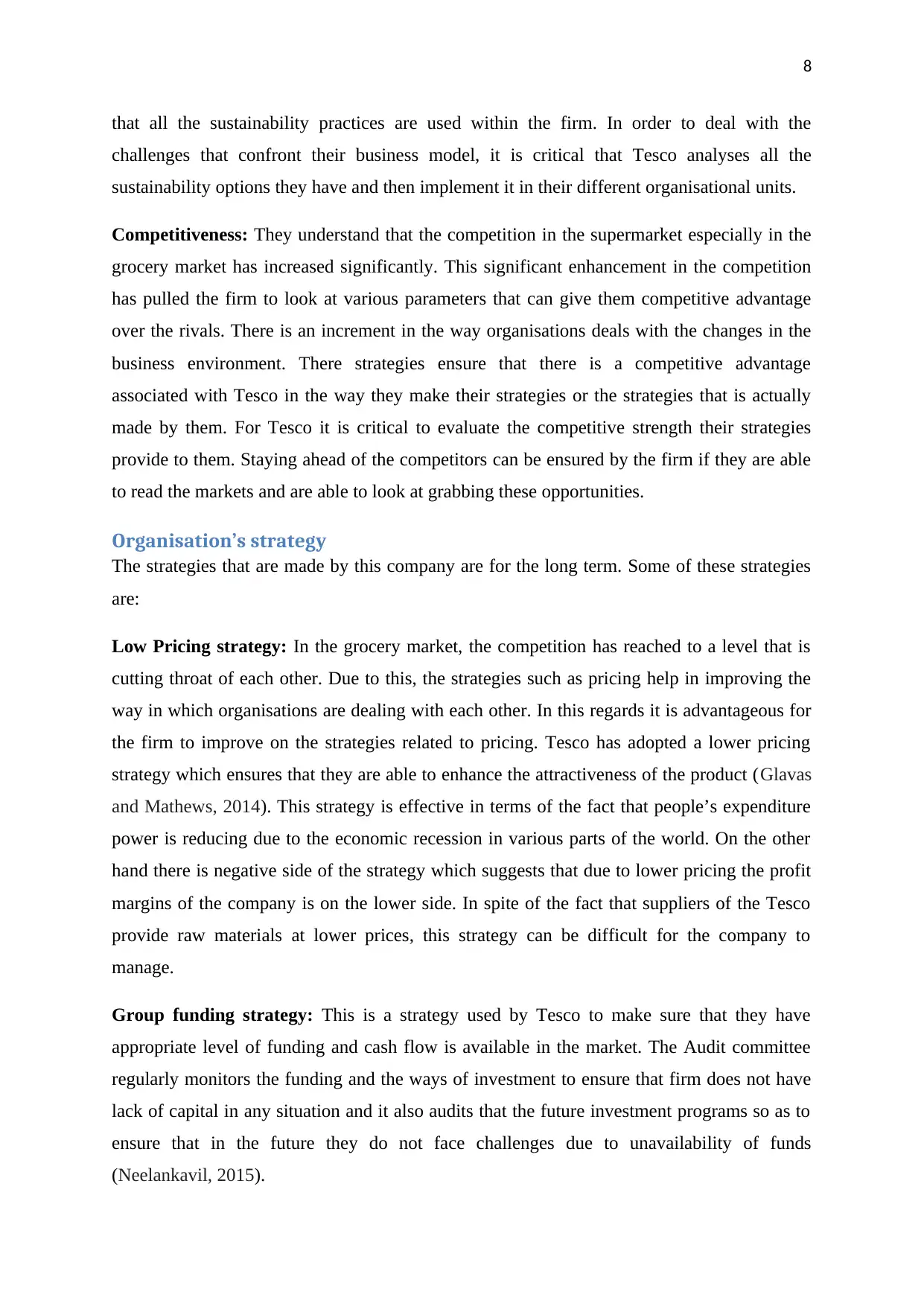
8
that all the sustainability practices are used within the firm. In order to deal with the
challenges that confront their business model, it is critical that Tesco analyses all the
sustainability options they have and then implement it in their different organisational units.
Competitiveness: They understand that the competition in the supermarket especially in the
grocery market has increased significantly. This significant enhancement in the competition
has pulled the firm to look at various parameters that can give them competitive advantage
over the rivals. There is an increment in the way organisations deals with the changes in the
business environment. There strategies ensure that there is a competitive advantage
associated with Tesco in the way they make their strategies or the strategies that is actually
made by them. For Tesco it is critical to evaluate the competitive strength their strategies
provide to them. Staying ahead of the competitors can be ensured by the firm if they are able
to read the markets and are able to look at grabbing these opportunities.
Organisation’s strategy
The strategies that are made by this company are for the long term. Some of these strategies
are:
Low Pricing strategy: In the grocery market, the competition has reached to a level that is
cutting throat of each other. Due to this, the strategies such as pricing help in improving the
way in which organisations are dealing with each other. In this regards it is advantageous for
the firm to improve on the strategies related to pricing. Tesco has adopted a lower pricing
strategy which ensures that they are able to enhance the attractiveness of the product (Glavas
and Mathews, 2014). This strategy is effective in terms of the fact that people’s expenditure
power is reducing due to the economic recession in various parts of the world. On the other
hand there is negative side of the strategy which suggests that due to lower pricing the profit
margins of the company is on the lower side. In spite of the fact that suppliers of the Tesco
provide raw materials at lower prices, this strategy can be difficult for the company to
manage.
Group funding strategy: This is a strategy used by Tesco to make sure that they have
appropriate level of funding and cash flow is available in the market. The Audit committee
regularly monitors the funding and the ways of investment to ensure that firm does not have
lack of capital in any situation and it also audits that the future investment programs so as to
ensure that in the future they do not face challenges due to unavailability of funds
(Neelankavil, 2015).
that all the sustainability practices are used within the firm. In order to deal with the
challenges that confront their business model, it is critical that Tesco analyses all the
sustainability options they have and then implement it in their different organisational units.
Competitiveness: They understand that the competition in the supermarket especially in the
grocery market has increased significantly. This significant enhancement in the competition
has pulled the firm to look at various parameters that can give them competitive advantage
over the rivals. There is an increment in the way organisations deals with the changes in the
business environment. There strategies ensure that there is a competitive advantage
associated with Tesco in the way they make their strategies or the strategies that is actually
made by them. For Tesco it is critical to evaluate the competitive strength their strategies
provide to them. Staying ahead of the competitors can be ensured by the firm if they are able
to read the markets and are able to look at grabbing these opportunities.
Organisation’s strategy
The strategies that are made by this company are for the long term. Some of these strategies
are:
Low Pricing strategy: In the grocery market, the competition has reached to a level that is
cutting throat of each other. Due to this, the strategies such as pricing help in improving the
way in which organisations are dealing with each other. In this regards it is advantageous for
the firm to improve on the strategies related to pricing. Tesco has adopted a lower pricing
strategy which ensures that they are able to enhance the attractiveness of the product (Glavas
and Mathews, 2014). This strategy is effective in terms of the fact that people’s expenditure
power is reducing due to the economic recession in various parts of the world. On the other
hand there is negative side of the strategy which suggests that due to lower pricing the profit
margins of the company is on the lower side. In spite of the fact that suppliers of the Tesco
provide raw materials at lower prices, this strategy can be difficult for the company to
manage.
Group funding strategy: This is a strategy used by Tesco to make sure that they have
appropriate level of funding and cash flow is available in the market. The Audit committee
regularly monitors the funding and the ways of investment to ensure that firm does not have
lack of capital in any situation and it also audits that the future investment programs so as to
ensure that in the future they do not face challenges due to unavailability of funds
(Neelankavil, 2015).
⊘ This is a preview!⊘
Do you want full access?
Subscribe today to unlock all pages.

Trusted by 1+ million students worldwide
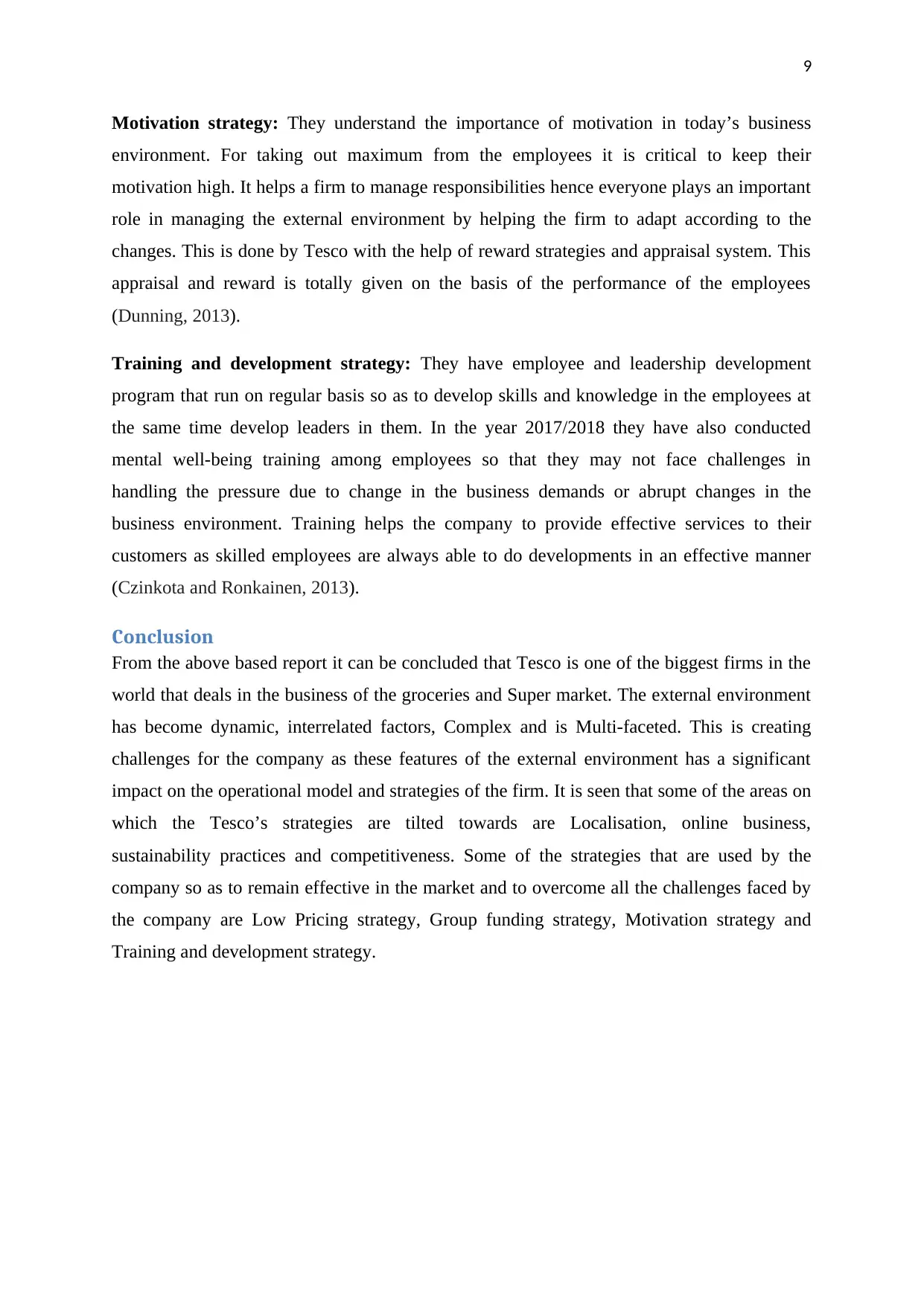
9
Motivation strategy: They understand the importance of motivation in today’s business
environment. For taking out maximum from the employees it is critical to keep their
motivation high. It helps a firm to manage responsibilities hence everyone plays an important
role in managing the external environment by helping the firm to adapt according to the
changes. This is done by Tesco with the help of reward strategies and appraisal system. This
appraisal and reward is totally given on the basis of the performance of the employees
(Dunning, 2013).
Training and development strategy: They have employee and leadership development
program that run on regular basis so as to develop skills and knowledge in the employees at
the same time develop leaders in them. In the year 2017/2018 they have also conducted
mental well-being training among employees so that they may not face challenges in
handling the pressure due to change in the business demands or abrupt changes in the
business environment. Training helps the company to provide effective services to their
customers as skilled employees are always able to do developments in an effective manner
(Czinkota and Ronkainen, 2013).
Conclusion
From the above based report it can be concluded that Tesco is one of the biggest firms in the
world that deals in the business of the groceries and Super market. The external environment
has become dynamic, interrelated factors, Complex and is Multi-faceted. This is creating
challenges for the company as these features of the external environment has a significant
impact on the operational model and strategies of the firm. It is seen that some of the areas on
which the Tesco’s strategies are tilted towards are Localisation, online business,
sustainability practices and competitiveness. Some of the strategies that are used by the
company so as to remain effective in the market and to overcome all the challenges faced by
the company are Low Pricing strategy, Group funding strategy, Motivation strategy and
Training and development strategy.
Motivation strategy: They understand the importance of motivation in today’s business
environment. For taking out maximum from the employees it is critical to keep their
motivation high. It helps a firm to manage responsibilities hence everyone plays an important
role in managing the external environment by helping the firm to adapt according to the
changes. This is done by Tesco with the help of reward strategies and appraisal system. This
appraisal and reward is totally given on the basis of the performance of the employees
(Dunning, 2013).
Training and development strategy: They have employee and leadership development
program that run on regular basis so as to develop skills and knowledge in the employees at
the same time develop leaders in them. In the year 2017/2018 they have also conducted
mental well-being training among employees so that they may not face challenges in
handling the pressure due to change in the business demands or abrupt changes in the
business environment. Training helps the company to provide effective services to their
customers as skilled employees are always able to do developments in an effective manner
(Czinkota and Ronkainen, 2013).
Conclusion
From the above based report it can be concluded that Tesco is one of the biggest firms in the
world that deals in the business of the groceries and Super market. The external environment
has become dynamic, interrelated factors, Complex and is Multi-faceted. This is creating
challenges for the company as these features of the external environment has a significant
impact on the operational model and strategies of the firm. It is seen that some of the areas on
which the Tesco’s strategies are tilted towards are Localisation, online business,
sustainability practices and competitiveness. Some of the strategies that are used by the
company so as to remain effective in the market and to overcome all the challenges faced by
the company are Low Pricing strategy, Group funding strategy, Motivation strategy and
Training and development strategy.
Paraphrase This Document
Need a fresh take? Get an instant paraphrase of this document with our AI Paraphraser
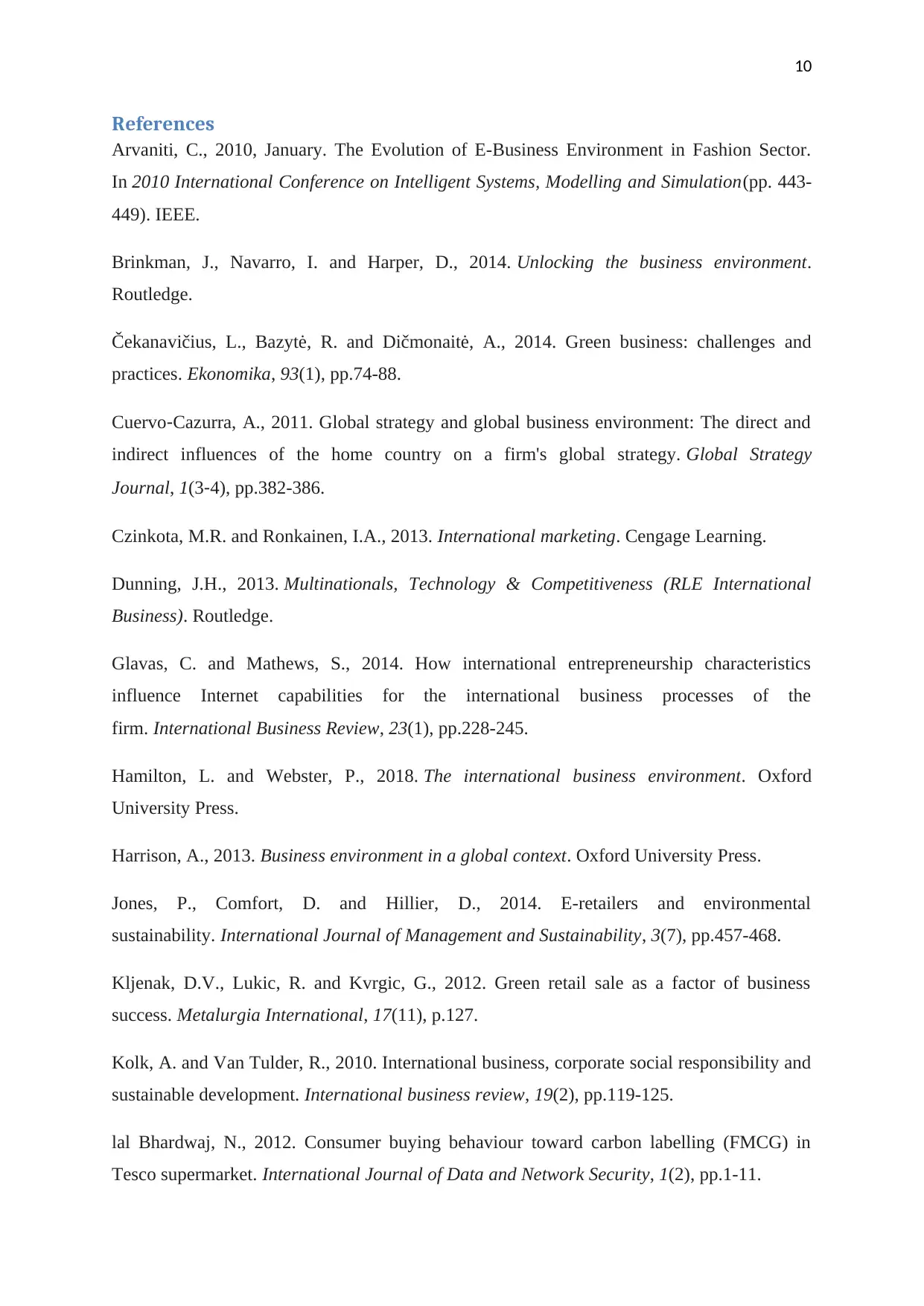
10
References
Arvaniti, C., 2010, January. The Evolution of E-Business Environment in Fashion Sector.
In 2010 International Conference on Intelligent Systems, Modelling and Simulation(pp. 443-
449). IEEE.
Brinkman, J., Navarro, I. and Harper, D., 2014. Unlocking the business environment.
Routledge.
Čekanavičius, L., Bazytė, R. and Dičmonaitė, A., 2014. Green business: challenges and
practices. Ekonomika, 93(1), pp.74-88.
Cuervo‐Cazurra, A., 2011. Global strategy and global business environment: The direct and
indirect influences of the home country on a firm's global strategy. Global Strategy
Journal, 1(3‐4), pp.382-386.
Czinkota, M.R. and Ronkainen, I.A., 2013. International marketing. Cengage Learning.
Dunning, J.H., 2013. Multinationals, Technology & Competitiveness (RLE International
Business). Routledge.
Glavas, C. and Mathews, S., 2014. How international entrepreneurship characteristics
influence Internet capabilities for the international business processes of the
firm. International Business Review, 23(1), pp.228-245.
Hamilton, L. and Webster, P., 2018. The international business environment. Oxford
University Press.
Harrison, A., 2013. Business environment in a global context. Oxford University Press.
Jones, P., Comfort, D. and Hillier, D., 2014. E-retailers and environmental
sustainability. International Journal of Management and Sustainability, 3(7), pp.457-468.
Kljenak, D.V., Lukic, R. and Kvrgic, G., 2012. Green retail sale as a factor of business
success. Metalurgia International, 17(11), p.127.
Kolk, A. and Van Tulder, R., 2010. International business, corporate social responsibility and
sustainable development. International business review, 19(2), pp.119-125.
lal Bhardwaj, N., 2012. Consumer buying behaviour toward carbon labelling (FMCG) in
Tesco supermarket. International Journal of Data and Network Security, 1(2), pp.1-11.
References
Arvaniti, C., 2010, January. The Evolution of E-Business Environment in Fashion Sector.
In 2010 International Conference on Intelligent Systems, Modelling and Simulation(pp. 443-
449). IEEE.
Brinkman, J., Navarro, I. and Harper, D., 2014. Unlocking the business environment.
Routledge.
Čekanavičius, L., Bazytė, R. and Dičmonaitė, A., 2014. Green business: challenges and
practices. Ekonomika, 93(1), pp.74-88.
Cuervo‐Cazurra, A., 2011. Global strategy and global business environment: The direct and
indirect influences of the home country on a firm's global strategy. Global Strategy
Journal, 1(3‐4), pp.382-386.
Czinkota, M.R. and Ronkainen, I.A., 2013. International marketing. Cengage Learning.
Dunning, J.H., 2013. Multinationals, Technology & Competitiveness (RLE International
Business). Routledge.
Glavas, C. and Mathews, S., 2014. How international entrepreneurship characteristics
influence Internet capabilities for the international business processes of the
firm. International Business Review, 23(1), pp.228-245.
Hamilton, L. and Webster, P., 2018. The international business environment. Oxford
University Press.
Harrison, A., 2013. Business environment in a global context. Oxford University Press.
Jones, P., Comfort, D. and Hillier, D., 2014. E-retailers and environmental
sustainability. International Journal of Management and Sustainability, 3(7), pp.457-468.
Kljenak, D.V., Lukic, R. and Kvrgic, G., 2012. Green retail sale as a factor of business
success. Metalurgia International, 17(11), p.127.
Kolk, A. and Van Tulder, R., 2010. International business, corporate social responsibility and
sustainable development. International business review, 19(2), pp.119-125.
lal Bhardwaj, N., 2012. Consumer buying behaviour toward carbon labelling (FMCG) in
Tesco supermarket. International Journal of Data and Network Security, 1(2), pp.1-11.
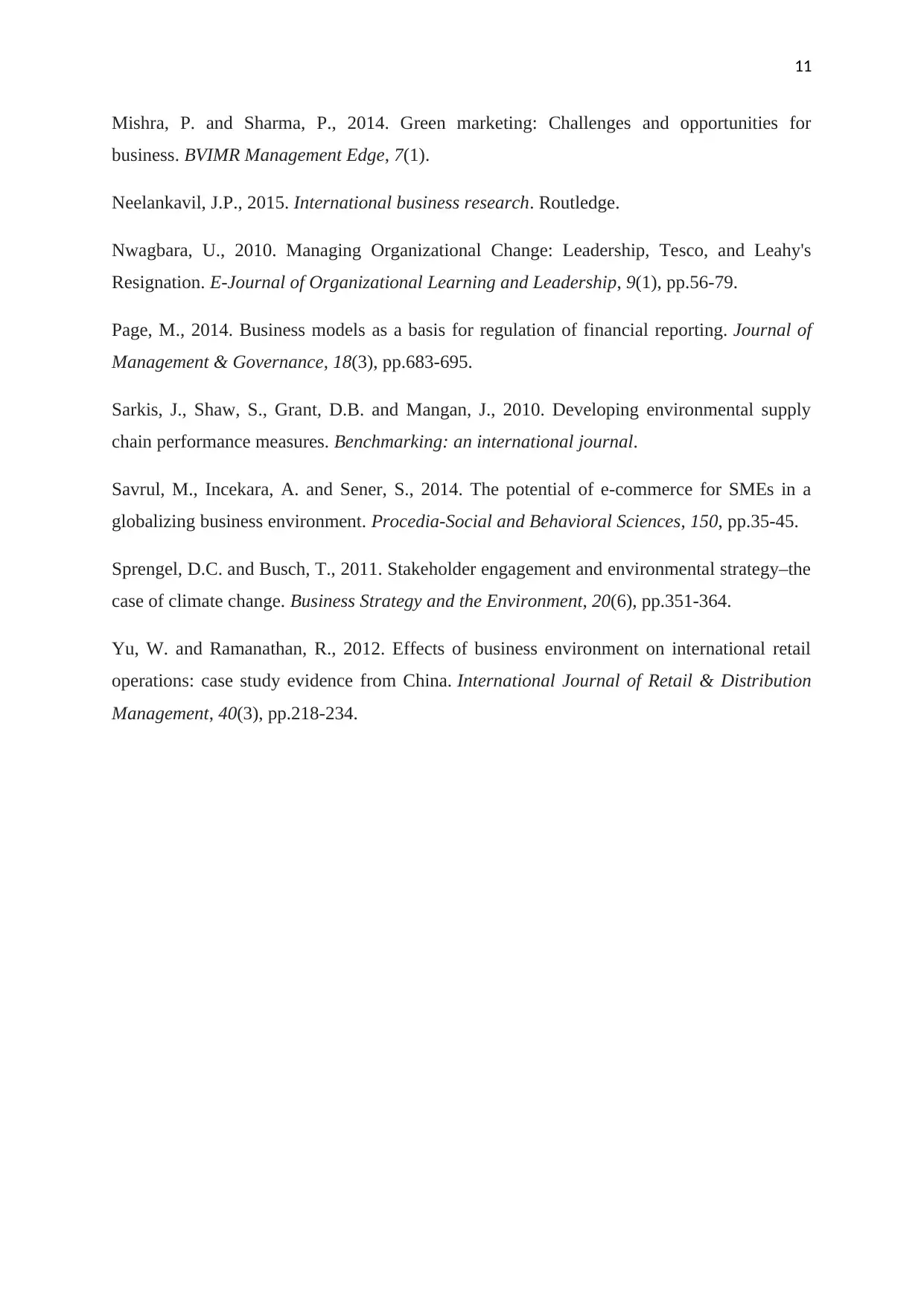
11
Mishra, P. and Sharma, P., 2014. Green marketing: Challenges and opportunities for
business. BVIMR Management Edge, 7(1).
Neelankavil, J.P., 2015. International business research. Routledge.
Nwagbara, U., 2010. Managing Organizational Change: Leadership, Tesco, and Leahy's
Resignation. E-Journal of Organizational Learning and Leadership, 9(1), pp.56-79.
Page, M., 2014. Business models as a basis for regulation of financial reporting. Journal of
Management & Governance, 18(3), pp.683-695.
Sarkis, J., Shaw, S., Grant, D.B. and Mangan, J., 2010. Developing environmental supply
chain performance measures. Benchmarking: an international journal.
Savrul, M., Incekara, A. and Sener, S., 2014. The potential of e-commerce for SMEs in a
globalizing business environment. Procedia-Social and Behavioral Sciences, 150, pp.35-45.
Sprengel, D.C. and Busch, T., 2011. Stakeholder engagement and environmental strategy–the
case of climate change. Business Strategy and the Environment, 20(6), pp.351-364.
Yu, W. and Ramanathan, R., 2012. Effects of business environment on international retail
operations: case study evidence from China. International Journal of Retail & Distribution
Management, 40(3), pp.218-234.
Mishra, P. and Sharma, P., 2014. Green marketing: Challenges and opportunities for
business. BVIMR Management Edge, 7(1).
Neelankavil, J.P., 2015. International business research. Routledge.
Nwagbara, U., 2010. Managing Organizational Change: Leadership, Tesco, and Leahy's
Resignation. E-Journal of Organizational Learning and Leadership, 9(1), pp.56-79.
Page, M., 2014. Business models as a basis for regulation of financial reporting. Journal of
Management & Governance, 18(3), pp.683-695.
Sarkis, J., Shaw, S., Grant, D.B. and Mangan, J., 2010. Developing environmental supply
chain performance measures. Benchmarking: an international journal.
Savrul, M., Incekara, A. and Sener, S., 2014. The potential of e-commerce for SMEs in a
globalizing business environment. Procedia-Social and Behavioral Sciences, 150, pp.35-45.
Sprengel, D.C. and Busch, T., 2011. Stakeholder engagement and environmental strategy–the
case of climate change. Business Strategy and the Environment, 20(6), pp.351-364.
Yu, W. and Ramanathan, R., 2012. Effects of business environment on international retail
operations: case study evidence from China. International Journal of Retail & Distribution
Management, 40(3), pp.218-234.
⊘ This is a preview!⊘
Do you want full access?
Subscribe today to unlock all pages.

Trusted by 1+ million students worldwide
1 out of 19
Related Documents
Your All-in-One AI-Powered Toolkit for Academic Success.
+13062052269
info@desklib.com
Available 24*7 on WhatsApp / Email
![[object Object]](/_next/static/media/star-bottom.7253800d.svg)
Unlock your academic potential
Copyright © 2020–2025 A2Z Services. All Rights Reserved. Developed and managed by ZUCOL.




